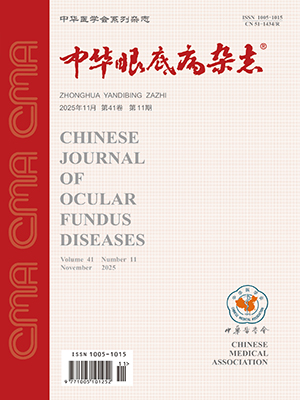| 1. |
Molday RS, Kellner U, Weber BH. X-linked juvenile retinoschisis: clinical diagnosis, genetic analysis, and molecular mechanisms[J]. Prog Retin Eye Res, 2012, 31(3): 195-212. DOI: 10.1016/j.preteyeres.2011.12.002.
|
| 2. |
Rao P, Dedania VS, Drenser KA. Congenital X-linked retinoschisis: an updated clinical review[J]. Asia Pac J Ophthalmol (Phila), 2018, 7(3): 169-175. DOI: 10.22608/APO.201803.
|
| 3. |
Xiao S, Sun W, Xiao X, et al. Clinical and genetic features of retinoschisis in 120 families with rs1 mutations[J/OL]. Br J Ophthalmol, 2021, 13: bjophthalmol-2021-319668[2021-10-13]. https://pubmed.ncbi.nlm.nih.gov/34645606/. DOI: 10.1136/bjophthalmol-2021-319668.
|
| 4. |
Pearson R, Jagger J. Sex linked juvenile retinoschisis with optic disc and peripheral retinal neovascularisation[J]. Br J Ophthalmol, 1989, 73(4): 311-313. DOI: 10.1136/bjo.73.4.311.
|
| 5. |
Ranchod TM, Faia LJ, Drenser KA. Peripapillary choroidal neovascularization in congenital retinoschisis[J]. Retin Cases Brief Rep, 2011, 5(4): 336-338. DOI: 10.1097/ICB.0b013e3181ff0960.
|
| 6. |
Ando A, Takahashi K, Sho K, et al. Histopathological findings of X-linked retinoschisis with neovascular glaucoma[J]. Graefe's Arch Clin Exp Ophthalmol, 2000, 238(1): 1-7. DOI: 10.1007/s004170050001.
|
| 7. |
Parra MM, Hartnett ME. Vitreous hemorrhage in X-linked retinoschisis[J/OL]. Am J Ophthalmol Case Rep, 2022, 25: 101395[2022-02-03].https://pubmed.ncbi.nlm.nih.gov/35198819/. DOI: 10.1016/j.ajoc.2022.101395.
|
| 8. |
Luo M, Du H, Ding H, et al. Peripheral retinal neovascularization secondary to highly myopic superficial retinoschisis: a case report[J]. BMC Ophthalmol, 2020, 20(1): 25. DOI: 10.1186/s12886-020-1308-6.
|
| 9. |
Campo RV, Reeser FH, Flindall RJ. Vascular leakage, neovascularization, and vitreous hemorrhage in senile bullous retinoschisis[J]. Am J Ophthalmol, 1983, 95(6): 826-832. DOI: 10.1016/0002-9394(83)90073-9.
|
| 10. |
Wu AL, Wu WC. Anti-VEGF for ROP and pediatric retinal diseases[J]. Asia Pac J Ophthalmol (Phila), 2018, 7(3): 145-151. DOI: 10.22608/APO.201837.
|
| 11. |
Hu QR, Huang LZ, Chen XL, et al. Genetic analysis and clinical features of X-linked retinoschisis in chinese patients[J/OL]. Sci Rep, 2017, 7: 44060[2017-03-08]. https://pubmed.ncbi.nlm.nih.gov/28272453/. DOI: 10.1038/srep44060.
|
| 12. |
Fahim AT, Ali N, Blachley T, et al. Peripheral fundus findings in X-linked retinoschisis[J]. Br J Ophthalmol, 2017, 101(11): 1555-1559. DOI: 10.1136/bjophthalmol-2016-310110.
|
| 13. |
Lewis TL, Maurer D. Multiple sensitive periods in human visual development: evidence from visually deprived children[J]. Dev Psychobiol, 2005, 46(3): 163-183. DOI: 10.1002/dev.20055.
|
| 14. |
Regillo CD, Tasman WS, Brown GC. Surgical management of complications associated with X-linked retinoschisis[J]. Arch Ophthalmol, 1993, 111(8): 1080-1086. DOI: 10.1001/archopht.1993.01090080076021.
|
| 15. |
Berenberg TL, Van Tassel SH, Patel SN, et al. Juvenile X-linked retinoschisis: a comparison of imaging modalities and review of angiographic findings[J/OL]. Retina, 2016, 36(12): e117-119[2016-12-01]. https://pubmed.ncbi.nlm.nih.gov/27164547/. DOI: 10.1097/IAE.0000000000001046.
|
| 16. |
Ferrara N, Gerber HP, Lecouter J. The biology of vegf and its receptors[J]. Nat Med, 2003, 9(6): 669-676. DOI: 10.1038/nm0603-669.
|
| 17. |
Green JL Jr, Jampol LM. Vascular opacification and leakage in X-linked (juvenile) retinoschisis[J]. Br J Ophthalmol, 1979, 63(5): 368-373. DOI: 10.1136/bjo.63.5.368.
|
| 18. |
Chatziralli I, Loewenstein A. Intravitreal anti-vascular endothelial growth factor agents for the treatment of diabetic retinopathy: a review of the literature[J/OL]. Pharmaceutics, 2021, 13(8): 1137[2021-07-26]. https://pubmed.ncbi.nlm.nih.gov/34452097/. DOI: 10.3390/pharmaceutics13081137.
|
| 19. |
Moradian S, Ahmadieh H, Malihi M, et al. Intravitreal bevacizumab in active progressive proliferative diabetic retinopathy[J]. Graefe's Arch Clin Exp Ophthalmol, 2008, 246(12): 1699-1705. DOI: 10.1007/s00417-008-0914-4.
|
| 20. |
Avery RL, Pearlman J, Pieramici DJ, et al. Intravitreal bevacizumab (Avastin) in the treatment of proliferative diabetic retinopathy[J/OL]. Ophthalmology, 2006, 113(10): 1695[2006-10-01]. https://pubmed.ncbi.nlm.nih.gov/17011951/. DOI: 10.1016/j.ophtha.2006.05.064.
|
| 21. |
Smith JM, Ward LT, Townsend JH, et al. Rhegmatogenous retinal detachment in children: clinical factors predictive of successful surgical repair[J]. Ophthalmology, 2019, 126(9): 1263-1270. DOI: 10.1016/j.ophtha.2018.11.001.
|
| 22. |
Wu WC, Drenser KA, Capone A, et al. Plasmin enzyme-assisted vitreoretinal surgery in congenital X-linked retinoschisis: surgical techniques based on a new classification system[J]. Retina, 2007, 27(8): 1079-1085. DOI: 10.1097/IAE.0b013e31806196d0.
|
| 23. |
Belin PJ, Lee AC, Greaves G, et al. The use of bevacizumab in pediatric retinal and choroidal disease: a review[J]. Eur J Ophthalmol, 2019, 29(3): 338-347. DOI: 10.1177/1120672119827773.
|
| 24. |
Jeffrey BG, Cukras CA, Vitale S, et al. Test-retest intervisit variability of functional and structural parameters in x-linked retinoschisis[J]. Transl Vis Sci Technol, 2014, 3(5): 5. DOI: 10.1167/tvst.3.5.5.
|
| 25. |
Verbakel SK, Van De Ven JP, Le Blanc LM, et al. Carbonic anhydrase inhibitors for the treatment of cystic macular lesions in children with X-linked juvenile retinoschisis[J]. Invest Ophthalmol Vis Sci, 2016, 57(13): 5143-5147. DOI: 10.1167/iovs.16-20078.
|
| 26. |
Zhou Y, Yang S, Yuan Y, et al. Progression and new onset of macular retinoschisis in myopic choroidal neovascularization eyes after conbercept therapy: a post-hoc analysis[J]. Eye (Lond), 2020, 34(3): 523-529. DOI: 10.1038/s41433-019-0516-x.
|
| 27. |
Ternant D, Paintaud G. Pharmacokinetics and concentration-effect relationships of therapeutic monoclonal antibodies and fusion proteins[J]. Expert Opin Biol Ther, 2005, 5(Suppl 1): S37-47. DOI: 10.1517/14712598.5.1.s37.
|
| 28. |
Wu WC, Lien R, Liao PJ, et al. Serum levels of vascular endothelial growth factor and related factors after intravitreous bevacizumab injection for retinopathy of prematurity[J]. JAMA Ophthalmol, 2015, 133(4): 391-397. DOI: 10.1001/jamaophthalmol.2014.5373.
|




